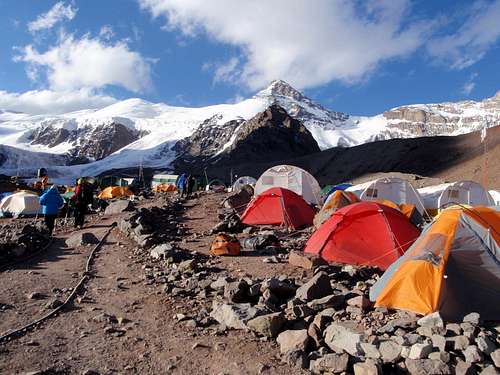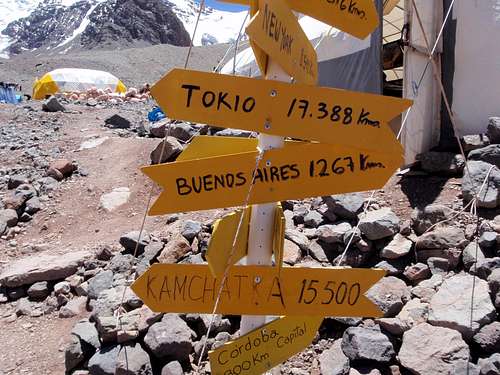-
 25187 Hits
25187 Hits
-
 82.48% Score
82.48% Score
-
 15 Votes
15 Votes
|
|
Hut/Campground |
|---|---|
|
|
32.64795°S / 70.05636°W |
|
|
Summer |
|
|
14400 ft / 4389 m |
Overview
Outside of Everest, Plaza de Mulas or "place of mules" is the largest base camp in the world. Located at 14,400 feet on a glacial moraine, 25 kilometers from the road, it is the staging area for the standard route on Aconcagua. Growing interest in South America's highest peak means that on any given year, Plaza de Mulas might be larger than the year before. In January of 2011 there were over two hundred tents. Plaza de Mulas gets it's name from the mule services which are responsible for bringing the heaviest gear up the mountain. The mules can carry up to 60 kilos. Plaza de Mulas is as far as they can go. For most climbers, Plaza de Mulas serves as the second camp with Confluencia being camp 1, but Mulas is the true base camp. This is where climbers spend their time between acclimatization hikes and also waiting out bad weather.
One kilometer across the valley from the main camp, constructed safely away from the moraine, is a large hotel. Although this building is not heated, it does have many nice services to offer including restaraunt, telephone, internet, post office, showers, gear rental, gas canisters, and porters. Take a look at their full list. But the hotel is not the only place to find amenities. Back in the main camp there are several giant tents set up as restaurants and there are also solar powered huts that sell hot showers.
For internet service you need only walk as far as the art gallery where Miguel Doura will sell you some time. Yes, that's right, I said art gallery. From December to March Miguel Doura lives in his tent, painting and sketching and displaying his work. He's proud to display a certificate from the Guiness Book of World Records stating that his art gallery is the highest in the world. Just outside his "Nautilus" tent he has the world's second highest web cam. See his website.
Although Aconcagua has a high number of fatalities each year, the medical services and rescue operations are carried out with precision. There is a medics hut directly across from the rangers hut. All climbers must pass a physical at the medics hut before being granted permission to climb higher. Weather forecasts can be found posted on the door of the rangers hut. Helicopter rescue costs are covered under the initial cost of the climbing permit but the helicopter can only fly as high as Nido des Condores camp at 18,300 feet. If you are too tired to walk down from Plaza de Mulas after climbing the mountain, you may purchase a ride on the helicopter for $500.
Aconcagua is not the only peak which is climbed from Plaza de Mulas. There are three other peaks which can be climbed. Bonete is the most popular for acclimatization, But Cerro Catedral and Cuerno are also worthy objectives. The massive southern glacier on Cuerno is the source of the Horncones River and it's what gives Plaza de Mulas its dramatic backdrop.
Webcam From AconcaguaNow.com
Live images every 3 minutes, December - March
Excerpt From My 2011 Trip Report
Plaza de Mulas was a very surreal place. We had just walked 16 miles through stark wilderness and here was a seasonal community the size of a small village, but filled with climbers from every corner of the world. Special services were offered here and there. We saw signs advertising hamburgers, pizza, beer, hot showers, and satellite internet connections. One sign even boasted the highest art gallery in the world including the world's highest webcam. There was a Japanese TV crew that was perusing around the camp, getting footage of people walking around in plastic boots and mountaineering garb. They took some clips of us as we walked up the trail. Even stranger was the army troop decked out in full camouflage. What the heck were they doing up here? Apparently climbing the mountain like everyone else.At one point in the afternoon, we heard a couple of loud booms that sounded suspiciously like gun shots. It must have been those army guys messing around. Stereos powered by generators blasted reggae here and there among the giant dome tents. Down by the medical hut a group of men played some form of football with their shirts off. And then the occasional mule would pass us by, seemingly knowing where it was going. There was even a hotel across the valley, constructed on solid ground, well away from the moraine. But the most impressive feature of the camp was not anything man-made. The west face of Aconcagua towered 8000 feet above us and it served as a constant reminder of where we were and the toil that lay ahead.







